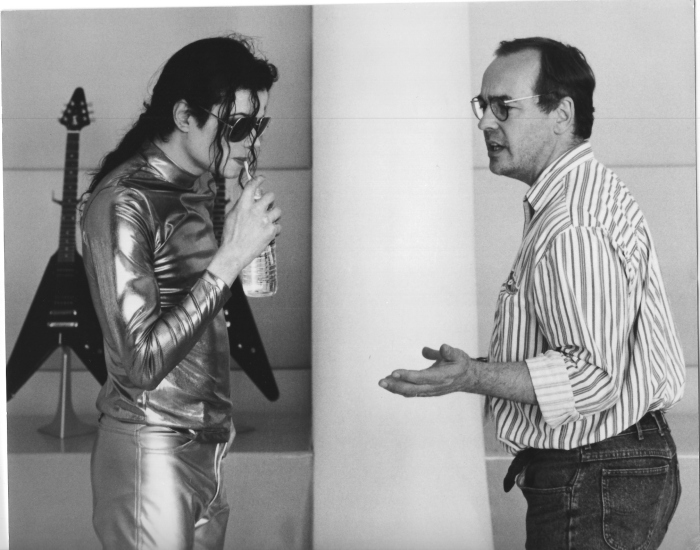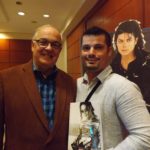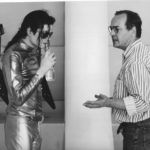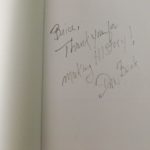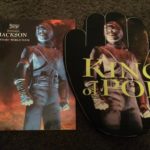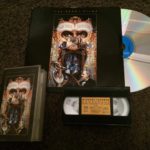In 2016, I had the pleasure to attend the Kingvention in London where I met Dan Beck, a close collaborative partner of the King of Pop and the SVP in Marketing & Sales at Sony Music in the 1990s. That’s how I recently reached him for an interview to discuss another side of the Jackson’s musical world with his agreement. I want to thank him again for his time and trust.
First, can you tell us about how you became a SVP in Marketing & Sales at Epic Records from 1974 to 1997?
It took many years of work to climb the ranks. I had been a music business trade journalist and then joined CBS Records (later Sony Music) as a publicist in 1974. I later became a product manager, handling coordination of releases and managing the marketing plans for dozens and dozens of artists over the years. Many of those artists had success – Luther Vandross, Cyndi Lauper, The Clash, Sade, Gloria Estefan, Pearl Jam, and on and on. I also was supervising and training other product managers. Our department was managing the production of music videos, as well. I didn’t become SVP until the early ‘90s, so it was a long process.
How did you start working with Michael Jackson in particular?
I initially worked with him in 1975-76, when the Jacksons were signed to Epic and I was head of publicity. Our first efforts were to have Michael feel comfortable at his new label. I took him to the National Zoo in Washington, DC and attended the National Black Caucus Dinner that same week with all the Jacksons. We had hired Steve Manning to be the PR liaison between Michael and Epic, and that seemed to make him very happy. He became very good friends with Susan Blond, who took my place in 1977, when I left to get in the artist management business. I returned in the marketing department at Epic in 1979, as a product manager.
The Dangerous album opened the beginning of the 90s, but also the next part of the MJ adventure without Quincy Jones. Was it easy to follow up with the record-breaking artist of the 1980s or on the contrary was it difficult to keep the same level in terms of marketing?
After the unprecedented success of “Thriller” there was actually some media backlash to “Bad,” since it “only sold” 5 million in the U.S. in its first year or so. I believe Michael also may have expressed some disappointment in those sales levels too. So there was a lot of pressure on the “Dangerous” release to at least do as well as “Bad.” I became product manager just weeks before its release, so it was a mad scramble for me. He really didn’t know me after all those years had passed from our brief earlier encounters. Fortunately, Larry Stessel, who had been Michael’s product manager, had done a great job getting most of the tools in position before he left Epic. However, the biggest challenge was that the media had begun shifting their coverage of Michael to non-music issues and more tabloid type of coverage. The hyperbaric chamber and Elephant Man stories were gaining more and more traction. As a record company, our job was to sell his music, so the challenge was to keep the public focused on the music.
The promotion of the « Dangerous » album included a multifaceted marketing campaign with the Superbowl and the live interview with Oprah Winfrey among others. How was the decision made to have more appearances of Michael Jackson himself in the media ? Do you remember discussing that campaign with him?
We urged Michael and his manager, Sandy Gallin, to not get baited by the media with all the extraneous coverage. I’m sure that was hard for Michael, when some of them were attacking him. This is long before all that we see on social media today. Michael was virtually alone as a superstar in dealing with the extreme degree of those kinds of attacks we see so much today on celebrities. Dave Glew, who was Chairman of Epic, Polly Anthony, who headed promotion, and I were constant in our efforts to keep it about the music for fear of all the non-music distractions. We continually looked for opportunities that were specifically about his music and his abilities as a performer.
The project entitled « Dangerous, The Short Films » probably remains the most satisfying video recording for the fans in terms of content since it includes many behind-the-scenes footage and of course, the short films themselves. How did you conceive that project and discuss it with Michael Jackson himself ?
“The Making of Thriller” had been such a huge home video success, and it was actually done outside of Epic. Then, there was not a home video follow up to coincide with the “Bad” album, which I thought was an enormous lost opportunity. Although we were too late to get a home video out to coincide with the release of “Dangerous,” I knew that we had the visual and musical assets to make a really great film. I also thought that we could get it assembled in a matter of weeks to meld into our marketing campaign for the album. When I mentioned it to Michael in our first meeting to review the launch of the album, he got really excited about the idea of the home video. I think it was a real bonding thing for me with him. It was at that point that he realized I was looking for ways to maximize and expand his music and image. I quickly laid out how we could get it done relatively fast and I had notes about what footage we could include. He loved my ideas and immediately brought up three or four other elements that he thought would be great and promised to get them to me quickly. Within the next 24-hours, I hired Propaganda Films to put it all together. Michael immediately got all the footage he was thinking about to our editing team. We literally had 99% of the content within a few days. However, it took us about 14 months of editing to get it to Michael’s satisfaction! He and I and the editors/producers spent countless hours every week for over a year to get it finished. It was at times, exasperating! That’s when I learned what a perfectionist Michael was!
Then, Michael made his most autobiographical album, « HIStory », following a terrible ordeal. When you visited him in the studio during the creative process, could you feel it would be a special album in his career?
Originally, the idea was the typical one-disc greatest hits. Ten hits, plus two new songs, as singles to drive sales. Dave Glew and I took a trip to LA and visited Michael in the studio, and he had five songs in the recording process that he was excited about and wanted to include. I didn’t know how we were going to get all his hits on one disc to begin with! Dave was extremely eager to get the album, as the billing was really important to Epic and Sony. The sooner the better! Dave relented to the idea of a double album.
How did the concept of the statue come up? Looking back, don’t you think that was the most amazing marketing campaign in your career?
Once Michael fell in love with the concept of “HIStory,” he ran with it. My original idea was to have the cover be a montage of iconic elements from his career — the white sox and Weejuns, a handwritten lyric, the white glove, etc. However, Michael’s concept of “HIStory” was very different. And yes, it was the most comprehensive, enormous, almost military driven campaign I ever oversaw.
You were indeed credited for the title of the album. Can you tell us that great story, please?
I was on the phone with Sandy Gallin and in our efforts to get the release moving, I asked him if Michael had a title for the album. He said that Michael didn’t. I asked him to check with Michael to see what he was thinking. Sandy said, “Why don’t you guys come up with something?” I was actually taken aback, and said to Sandy that I thought it was such a personal thing that we should leave that to Michael. He called me back the next day and said Michael didn’t have a name in mind and that we (Epic) should work on it. I took that to Dave and Polly. Polly said wistfully, “I wish he would come up with something as cool as Madonna’s ‘Immaculate Collection.” That night on the train home, I thought of the HIStory idea in the same way of playing on words. I had worked with Cyndi Lauper, and Cyndi had used the idea of herstory. In this case, the hits album was his history and the new album was his response to all the controversy, which was his story. I just put them together.
Let’s not forget the teaser of the album that was shot in Budapest. Once again, can you tell us how it was conceived? Do you think it was misinterpreted and slowed down the promotion of the album?
That was all Michael. It tied into his cover idea, and he loved classical music. We (at Epic) were not enamored with the idea. It didn’t tease his new music, and we just thought he would take a lot of negative heat for it in the media being over-the-top. However, Sony wanted the album so bad, it was determined to give him anything he wanted to get the album delivered. It complicated the launch, because of the negative press. We weathered through it.
At the time of the release, how were the singles chosen? Were there many conversations with Michael himself to decide?
I don’t think there was any question that “Scream” and the duet with Janet had to be the first single. Just the idea of them together was awesome! Plus, the song was uptempo and would immediately go on virtually every format of radio. “You Are Not Alone” was a clear second choice — the softer side and a song our Urban promotion department really embraced. It was the perfect one/two punch.
Any anecdotes you would like to share about the shootings of music videos? Was it a special aspect of your job to go and visit artists on the set of videos?
I was often on set for some of our bigger budget and most important videos for our artists. I was never there to get in the way of a production, but to be there to make sure the artist was happy and to engage in any problem-solving or relationship issues with the production company and director. This was a huge budget. I was there and I had our video production maven Scott Spangich there for most of it. It took 11 days on the Universal lot in Burbank.
It is notorious that Michael Jackson didn’t really like going on tour. Did you have to negotiate with him for the HIStory Tour?
The HIStory tour was really an international priority. The media controversies in the U.S. I believe influenced Michael and his management to keep it that way. I think Michael’s only reluctance might have been making sure he was prepared with the best show possible and also ready for the incredible endurance that it required of him.
Regarding the HIStory Tour set-list, did the record company have a say about the number of new songs to be included in order to promote the album?
Again, that would have been an international company issue, but of course, we would have encouraged that the new material from the album be represented well in the live show.
Between an artist like Michael Jackson creating his own music and a record company that has to make profits, there must be a risk of some disagreement. Did your mission also include meeting up with him as often as possible in order to discuss and agree on most of the issues?
We had many, many meetings regarding the media and marketing. Michael and I were on the phone constantly for the six months before the album came out — workdays, weekends, very often in the middle of the night. Most meetings were exciting and positive. The media backlash as the album was released provided some intense meetings with Michael, Sandy Gallin and Jim Morey, and the key people at Epic. However, it was always about finding the right answers for Michael. There were debates, but really about how to handle the external issues. Those were tough times for Michael, and for all of us. It was sometimes painful, but we were all feeling the pain together.
When you left Epic Records, did you have the opportunity to let Michael know and did the two of you stay in touch afterwards?
Michael was just launching the HIStory tour when I gave my notice to Epic that I was launching V2 Records for Richard Branson in North America. Michael was really enormously engaged in his work internationally and with the tour, so we never really did connect in regard to my departure. After that, Michael’s life got very complicated and I just never thought of it as appropriate to try to re-connect amid the challenges in his life. I understand the demands upon the lives of superstars. I worked in service to him. I ached for all his troubles, but never felt that he had to re-connect with me. A year or two after I left V2, Michael’s image was going through such enormous challenges that I once reached out to John Branca to offer help if needed. John responded almost immediately, asking what I had in mind. But then I realized there was no way of getting involved again without it being 24/7. Michael’s career was all-consuming. You could not be involved unless you were immersed. I realized I just could not go back into that fire.
Among your whole career, where do you put your work and collaboration with Michael Jackson?
There is absolutely nothing that compared to working with Michael. I worked with many superstars, but the circumstances around his career were so huge and complicated. People need to know that a career that gargantuan takes tolls on everyone. I really, really liked Michael and loved working with him. He was actually so easy to work with. He was such a generous and enthusiastic collaborator. He always gave credit. However, the pressures and outside forces on his life and career were often very tough to bear. I’m so happy that he had those children to give him happiness in the latter years of his life. In the end, I believe, they were what mattered to him and were his salvation on this earth.
